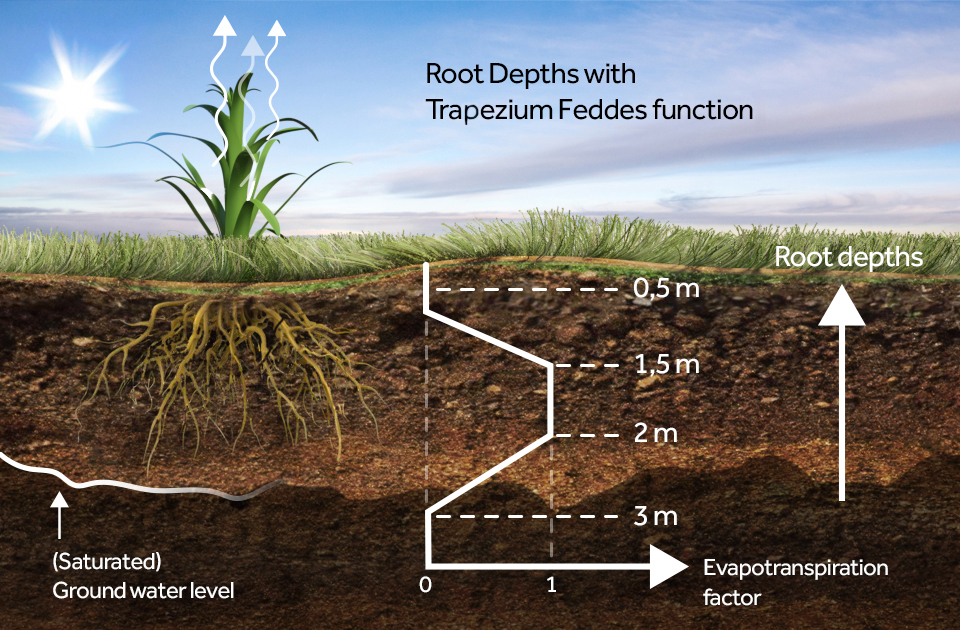Ground evaporation formula (Water Overlay): Difference between revisions
No edit summary |
No edit summary |
||
| Line 5: | Line 5: | ||
The amount a plant, crop or tree evaporates also depends on its growth season. Therefore, the species specific [[Water evaporation (Function Value)|Water evaporation function value]] can be set as four [[Season formula (Water Overlay)|seasonal values]]. | The amount a plant, crop or tree evaporates also depends on its growth season. Therefore, the species specific [[Water evaporation (Function Value)|Water evaporation function value]] can be set as four [[Season formula (Water Overlay)|seasonal values]]. | ||
This evaporation is calculated per cell. | This evaporation is calculated per cell. For all ground evaporation calculation, the ground water depth at time t is used. | ||
For all ground evaporation calculation, the ground water depth at time t is used. | |||
<math>d_{gw,t} = B_{c} - w_{g,t}</math> | <math>d_{gw,t} = B_{c} - w_{g,t}</math> | ||
Revision as of 13:24, 27 February 2024
Conceptually, water can evaporate from the ground via crop, tree and plant foliage. This is called evapotranspiration. The amount a plant can evaporate depends on the saturation and ground water level, as well as the root structure. The factor by which roots can extract water from the ground is modeled using the Feddes trapezium.
The amount a plant, crop or tree evaporates also depends on its growth season. Therefore, the species specific Water evaporation function value can be set as four seasonal values.
This evaporation is calculated per cell. For all ground evaporation calculation, the ground water depth at time t is used.
Feddes oxygen stress factor:
Feddes saturated zone root update factor:
Seasonal transpiration factor:
Max potential evaporation:
Evaporation unsaturated:
Potential evaporation saturated:
Evaporation saturated zone:
Evaporation total is the sum of evaporation in the saturated and unsaturated zone:
where
- = the datum height of the surface of cell c, set by the elevation or a Terrain elevation prequel.
- = the ground water level (datum height) at time t.
- = the depth of the ground water level, which is equal to the column height of the unsaturated zone at time t.
- = the transpiration factor at current season c, of the buildings (plants) on the surface, or the surface terrain's transpiration factor if none present.
- = the transpiration factor at coming season n, of the buildings (plants) on the surface, or the surface terrain's transpiration factor if none present.
- = Season fraction. Used for interpolating the transpiration factor.
- = Can be supplied as four values; it is an interpolated value based on the current and next season.
- = the evaporation rate of the weather at time t
- = the calculated feddes oxygen stress factor, calculated using the 3rd and 4th root depths and the feddes trapezium interpolation model and the ground water depth.
- = the calculated feddes saturated zone root update factor, calculated using the 1st and 2nd root depths and the feddes trapezium interpolation model and the ground water depth.
- = The ground bottom distance of the cell c, defined by a Bottom distance prequel or a general GROUND_BOTTOM_DISTANCE_M of the Water Overlay.
- = the column height of the saturated zone covered by the roots
- = the nth root depth value.
- = the amount of water in the unsaturated zone.
- = the potential max evaporation
- = the evaporation in the unsaturated zone
- = the potential evaporation in the saturated zone
- = The WATER_STORAGE_PERCENTAGE of the ground terrain type, used here as a fraction.
- = the evaporation in the saturated zone
- = the total evaporation from the ground.
Related
The following topics are related to this formula.
- Formulas
- Groundwater level formula (Water Overlay)
- Models
- Ground model (Water Overlay)
- Evaporation model (Water Overlay)




































